The Leibniz-IZW is an internationally renowned German research institute. It is part of the Forschungsverbund Berlin e.V. and a member of the Leibniz Association. Our goal is to understand the adaptability of wildlife in the context of global change and to contribute to the enhancement of the survival of viable wildlife populations. For this purpose, we investigate the diversity of life histories, the mechanisms of evolutionary adaptations and their limits, including diseases, as well as the interrelations of wildlife with their environment and people. We use expertise from biology and veterinary medicine in an interdisciplinary approach to conduct fundamental and applied research – from the molecular to the landscape level – in close dialogue with the public and stakeholders. Additionally, we are committed to unique and high-quality services for the scientific community.
+++ Current information on African swine fever: The Leibniz-IZW conducts research on the population dynamics, on models of disease outbreaks in wild boars and on the ecology and human-wildlife interaction in urban areas. African swine fever is a reportable disease in domestic swine and therefor is the purview of the respective federal state laboratories and the Friedrich-Loeffler-Institut (Federal Research Institute for Animal Health) FLI. +++
News
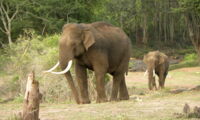
Environmental change: Asian elephants may lose up to 42 percent of suitable habitats in India and Nepal until 2070
Protecting and expanding suitable habitats for wildlife is key to the conservation of endangered species, but owing to climate and land use change the ideal habitats of today may not be fitting in 30 or 50 years. An international team of scientists therefore predicted range shifts of Asian elephants in India and Nepal using species distribution models based on distribution data for the elephants and climate projections. While a few regions in the north and northeast of the subcontinent may provide more suitable habitats in the future, overall a heavy loss is probable in all scenarios. The complex effects of environmental change on the distribution of the elephants is elucidated in a paper published in the Journal „Diversity and Distributions”.
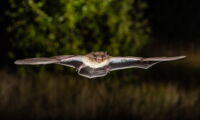
Batmobile with cruise control: Bats migrate at the most energy-efficient flying speed for maximum range
Aerial migration is the fastest, yet most energetically demanding way of seasonal movements between habitats. A new study led by scientists at the Leibniz Institute for Zoo and Wildlife Research (Leibniz-IZW) investigated the energy requirements and travel speeds of migrating Nathusius’ bats (Pipistrellus nathusii). Using a wind tunnel experiment to determine the exact energy demands of different flying speeds and a field study to record actual travel speeds of migrating bats, the scientists demonstrated that bats travel at the speed where their range reaches a maximum, enabling them to cover long distances with a minimum amount of energy. How the researchers tracked down this cruise control is published in the “Journal of Experimental Biology”.
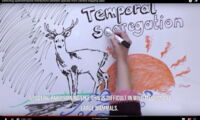
Studying species interactions using remote camera traps
Species are often involved in complex interactions with other species, which can affect their occurrence, abundance, feeding habits and disease transmission. Observing and studying species interactions can be difficult. To circumvent this problem, ecologists increasingly rely on remote devices such as camera traps. In a recent study carried out by researchers from the Leibniz Institute for Zoo- and Wildlife Research (Leibniz-IZW) in Germany and University of California, Davis, USA, the scientists explored to what extent camera trap data are suitable to assess subtle species interactions such as avoidance in space and time. The study is published in the international journal Remote Sensing in Ecology and Conservation.
Read more … Studying species interactions using remote camera traps
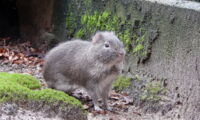
New epigenetic study reveals how guinea pig fathers pass on adaptive responses to environmental changes
Adaptations to environmental change are the most important asset for the persistence of any plant or animal species. This is usually achieved through genetic mutation and selection, a slow process driven by chance. Faster and more targeted are so called epigenetic modifications. They do not alter the genetic code but promote specialisations during cell maturation. A new study carried out by scientists from the Leibniz-IZW in Germany shows for wild guinea pigs that epigenetic modifications specific to individual environmental factors are passed on to the next generation. The study is published in the scientific journal “Genes”.
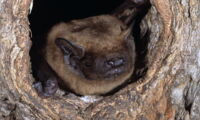
Multicultural creatures of habit – Long-term study reveals migratory patterns of bats
Every year trillions of animals migrate for thousands of kilometres between their summer and winter areas. Among them are several species of bats whose journeys in the dark of the night unfold largely unnoticed by humans and have only partially been investigated by science. A reconstruction of individual migration patterns of the common noctule (Nyctalus noctula) in Central Europe has now revealed that travelling distances vary largely among individuals, yet overall females cover longer distances than males. Local bat populations, which remain separate when females rear their offspring in summer, strongly mix in their hibernacula, the roost where they hibernate in winter. Additionally the study showed that individuals rarely change their migration habits – a behaviour that could prove problematic when bats are forced to adjust to rapidly changing ecosystems. The study was published in the „Proceedings of the Royal Society: Biological Sciences“.
Read more … Multicultural creatures of habit – Long-term study reveals migratory patterns of bats
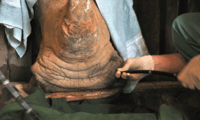
Lung lavage as new test method improves tuberculosis diagnosis in rhinoceros
Diseases and tuberculosis in particular can pose considerable challenges for wildlife. In order to avoid epidemics within populations or to treat individual animals belonging to highly endangered species, fast and reliable tests are paramount. However present tuberculosis testing in rhinos relies on skin tests developed in the 1960s and designed for cattle bearing high risk of false diagnosis in rhinos. To improve diagnostic standards an international team of scientists lead by institutes in Berlin and Jena, Germany, performed repeated lung lavage as a new approach for tuberculosis diagnosis in rhinoceros. Subsequent genetic tests reliably identified mycobacteria in the animals’ respiratory fluids – with minimal stress and risk for the rhinos. The study has been published in the journal PLOS ONE.
Read more … Lung lavage as new test method improves tuberculosis diagnosis in rhinoceros
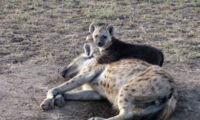
Hyena population recovered slowly from a disease epidemic
Infectious diseases can substantially reduce the size of wildlife populations, thereby affecting both the dynamics of ecosystems and biodiversity. Predicting the long-term consequences of epidemics is thus essential for conservation. Researchers from the Leibniz Institute for Zoo and Wildlife Research (Leibniz-IZW) in Berlin and from the Center for Functional Ecology and Evolution (CEFE) in Montpellier, France, have now developed a mathematical model ("matrix model") to determine the impact of a major epidemic of canine distemper virus (CDV) on the population of spotted hyenas in the Serengeti National Park in Tanzania. The results of the study are published in the new Nature open-access journal Communications Biology.
Read more … Hyena population recovered slowly from a disease epidemic
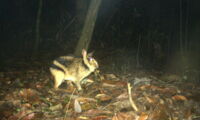
Fading stripes in Southeast Asia: First insight into the ecology of an elusive and threatened rabbit
The Annamite mountains of Vietnam and Lao PDR (Laos) harbour exceptional species richness and endemism, but its wildlife is under threat from widespread and intensive poaching. The region is home to the Annamite striped rabbit (Nesolagus timminsi), a little-known lagomorph only discovered by science in 1995. A new study carried out by the Leibniz Institute for Zoo- and Wildlife Research (Leibniz-IZW) in collaboration with WWF-Vietnam, WWF-Laos, and the Central Institute for Natural Resources and Environmental Sciences (CRES) of the Vietnam National University, provides the first detailed information about the species ecology. The study is published in the international journal Oryx.




